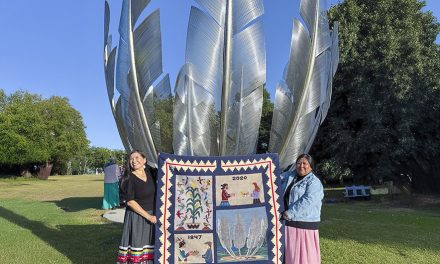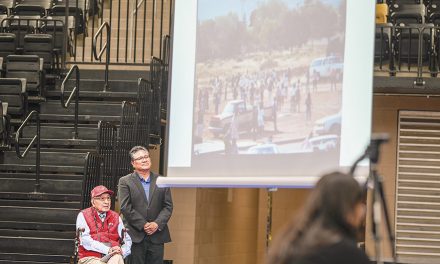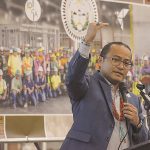
50 Years Ago: Culture office seeks funds, fed meets with youth
There was some bad news on the culture front 50 years ago this week as the Office of Navajo Economic Opportunity announced that it was closing its Navajo Culture Office, which had been headed by Carl Gorman, Navajo Code Talker, famous artist and cultural expert, for the previous two years. The program had received a two-year, $85,000 grant in 1966 to research how to preserve Navajo culture and was not renewed.
Gorman, however, said all was not lost since his office had received a lot of support from traditional Navajos who served on the Navajo Tribal Council and from medicine men and women. “I’m hoping that the Council will find the funding so we can continue to operate when the funding runs out in October,” Gorman said.
In its short existence, the office had begun a number of projects that Gorman said needed to be completed. The biggest one, he said, centered on efforts to provide – for the first time ever – a complete list of Navajo medicine men and women and the types of services they provide and ceremonies they perform.
That project was about half completed, said Gorman, adding that it was important for the tribe to learn which ceremonies were in danger of being lost because there were only a few medicine men who performed them and no one younger who was taking them up. “It takes years sometimes to learn some of these ceremonies,” Gorman said, “and if we want to preserve them, we will have to start doing it now.”
He said he had submitted a budget to the Council. The problem is that the budget for the next fiscal year, which begins Oct. 1, had already been approved by the Council so the tribe would have to find a revenue source in order to justify approving an addition to the budget.
In other news, Robert Bennett, the head guy in the BIA, did something rare among government officials – he spent time with young Navajos. It was hard to tell from the article that he wrote about the experience where it took place but since they were under the age of 18 and probably going to high school, it was probably at a BIA boarding school. And since he mentioned that he also talked to youth from other tribes, it was probably at the Intermountain Indian School in Brigham City, Utah.
He said he decided to meet with the students after he learned that more than half of the Native American population in the country was below the age of 18. “These meetings have been held in a friendly atmosphere and the young people have been courteous and considerate, as I knew they would,” said Bennett.
This is a good indication that wherever he went, the students were handpicked by the principals, because in 1968, the students at these BIA schools and especially those that included members of many tribes, were becoming political and asking hard questions about the relationship between the federal government and tribes. These were the days when groups like the American Indian Movement were getting attention.
Groups like Indians Against Exploitation were being organized on the Navajo Reservation to speak out on local concerns. “The traditional kindness and courtesy of the Indian people has not been lost in the young people,” Bennett said. “They have been positive in their views and opinions and it is apparent to me they want action.”
But exactly what kind of action do they want? It seemed to Bennett that the students wanted the federal government to come onto reservations and create a slew of businesses and replace old, dilapidated structures with modern facilities with electricity and running water. Many of the students, Bennett said, grew up in homes without electricity and running water and felt that correcting that problem should be the top priority of the federal government.
Bennett said he agreed but pointed out that there were money issues. He predicted, however, that by the end of the century, everyone on the Navajo Reservation would have running water and electricity. He didn’t emphasize this in his statement but he pushed the students to go to college and, when they graduate, to consider working for the BIA.
In 1968, the federal agency was still being run, for the most part, by non-Indians, especially in the specialty fields. Bennett said he would like to see the day when the majority of jobs and even those high-level positions would be filled by Native Americans. In fact, he said he could almost guarantee that a Native American with a college degree would be able to find a job somewhere in the federal government if they applied.
That issue of the Navajo Times also had an article that would become commonplace in future years – a tribe sending people to the reservation to see if something that was being done there could be duplicated on their own reservation. The Navajo Tribe was getting a lot recognition within Indian Country as being in the forefront of change and other tribes looked to the Navajos to lead the way, especially when it came to creating a court system.
In this issue of the Times 50 years ago, it wasn’t the tribe that was being given the attention but Rough Rock Demonstration School. A delegation of 16 people from the Chippewa Nation’s Upward Bound Program spent several days at the school, observing the classes and the way the teachers incorporated Navajo language and culture into the class work.
They were especially interested in looking at the materials the teachers used that had been developed by the school to help teach students Navajo culture and language. They wanted to create a Chippewa version to use in the Minneapolis school system because of fears that they would one day lose their identity because of the inability of the young population to speak the language or know the culture.
To read the full article, pick up your copy of the Navajo Times at your nearest newsstand Thursday mornings!
Are you a digital subscriber? Read the most recent three weeks of stories by logging in to your online account.








 Highway 264,
Highway 264, I-40, WB @ Winslow
I-40, WB @ Winslow